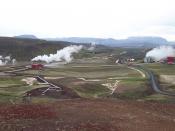I. Overview of Geothermal Energy Geothermal energy (from the Greek words geo [earth] and therme [heat], thus 'earth heat' energy) is a domestic energy resource with cost, reliability, and environmental advantages over conventional energy sources. Energy from this source comes from the renewable source of heat from deep in the Earth (diagram: A). Heat is brought up to near the surface by thermal conduction (diagram: B) and magma. This heat heats ground water to form hydrothermal resources (naturally occurring hot water/steam in fissures [diagram: C/D]). Wells (diagram: F) are drilled to tap fissures for hot water, and the steam can be used to generate electricity, as described in the next section. Hot water may also emerge on the surface as hot springs or geysers (diagram: E). Utilizing geothermal energy not only contributes to our energy supply, but also reduces energy demand (through the use of geothermal pumps to heat and cool buildings, reducing the need for natural gas and other nonrenewable resources).
It is unfortunate that only a small part of our geothermal resources are being used today.
Hot water, at temperatures between 300 and 700 degrees Fahrenheit, is brought from an underground reservoir to the surface and is converted to steam by using changes in pressure. The steam and liquid are separated, with the steam turning turbines (generating electricity) and the water is injected back into the reservoir to maintain the chamber's pressure.
Sometimes the hot water is used directly for home, and sometimes greenhouse, heating. It is also used to speed up the growth of aquatic animals (aquaculture).
II. Dependency on Geothermal Energy Although we (the United States) are not taking advantage of all of the geothermal sources in the United States, the source is here today; it is not merely a hope for the future. The production...


